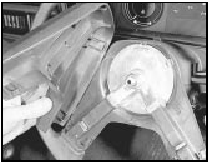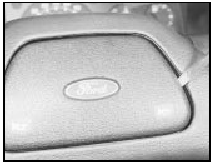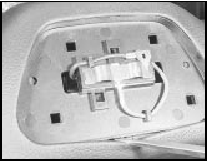Steering wheel - removal and refitting
Removal
1 According to model, either pull off the
steering wheel trim, prise out the insert which
carries the Ford motif at the centre, or carefully
prise up and lift off the horn push followed by
the contact plate (see illustrations).

22.1a Steering wheel trim removal

22.1b Prising up the steering wheel horn push . . .

22.1c . . . followed by the contact plate
2 Insert the ignition key and turn it to position I.
3 Hold the steering wheel from turning and have the front roadwheels in the straightahead attitude. Unscrew the steering wheel retaining nut using a socket and extension.
4 Withdraw the steering wheel from the shaft.
No great effort should be necessary, as the wheel is located on a hexagonal-section shaft, which does not normally cause the binding associated with splined shafts. However, if difficulty is experienced, a puller may be used to withdraw the wheel - take adequate precautions to avoid damage to the finish.
5 Where applicable note the steering shaft direction indicator cam which has its peg uppermost.
Refitting
6 Refitting is the reverse sequence to
removal. Ensure that the direction indicator
switch is in the neutral position (this will avoid
the possibility of damage to the selfcancelling
mechanism). Check that the
roadwheels are still in the straight-ahead
position and locate the steering wheel with
the larger section between the spokes
uppermost. Tighten the steering wheel
retaining nut to the specified torque.
See also:
General information
OHV engines
The 1.1 litre and 1.3 litre OHV engines are
of four-cylinder, in-line overhead valve type
(hence OHV), mounted transversely together
with the transmission, at the front of the car.
Th ...
Engine oil and filter renewal (Every 6000 miles or 6 months)
1 Frequent oil and filter changes are the most
important preventative maintenance
procedures that can be undertaken by the DIY
owner. As engine oil ages, it becomes diluted
and contaminated, which ...
Rear shock absorber (Saloon and Estate models) - removal,
testing and refitting
Removal
1 Slacken the roadwheel bolts, raise the rear
of the vehicle, support it on stands (see
“Jacking and Vehicle Support”) and remove
the roadwheel.
2 Support the suspension lower arm with a
...
